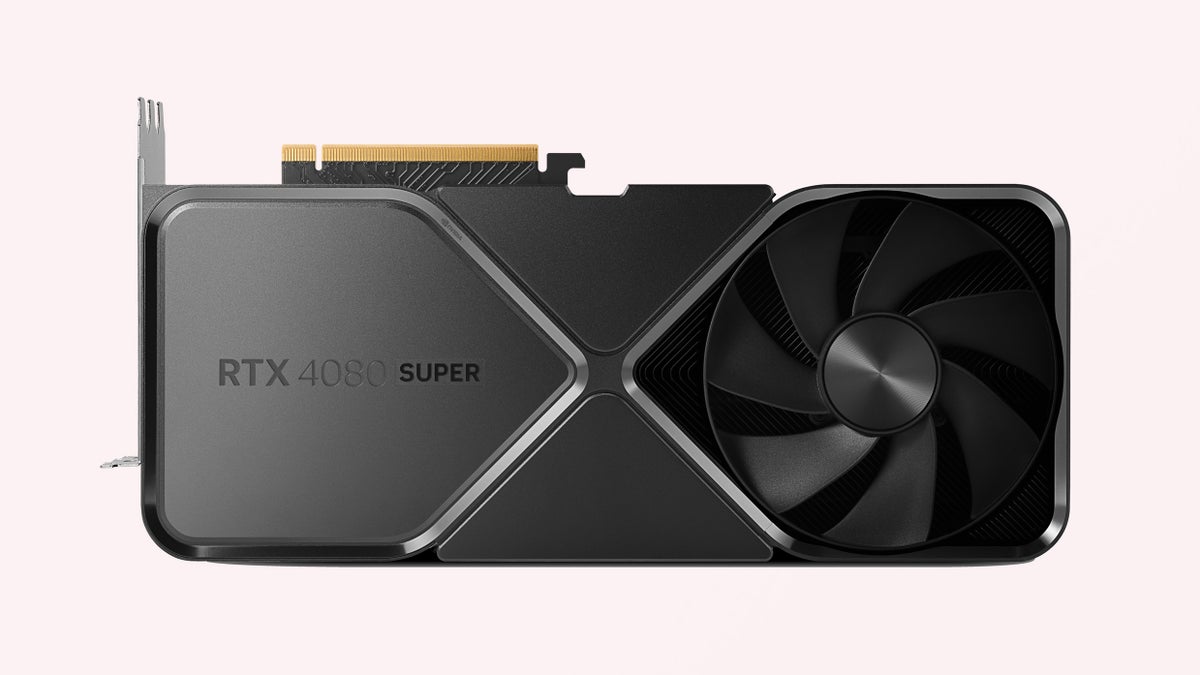
Nvidia announced its latest slew of RTX graphics cards in a press conference today to kick off CES 2024, with the RTX 40-series being extended with three new ‘Super’ variants: the $999/£959 RTX 4080 Super, the $799/£769 RTX 4070 Ti Super and the $599/£579 RTX 4070 Super. We’d already discussed these cards on this week’s DF Direct following comprehensive leaks, but the official announcement includes some fascinating extra details – and the combination of spec bumps plus price cuts in some cases could result in high-end GPUs becoming more affordable.
These new Super cards are set to be released throughout January at one week intervals, with RTX 4070 Super cards on shelves on the 17th, followed by 4070 Ti Supers on the 24th and 4080 Supers on the 31st – an intriguing strategy that may shore up availability. The 4080S and 4070S are set to be available in Nvidia Founders Editions in addition to the usual third-party options, while the 4070 Ti Super goes without a first-party FE model. Note that the 4080 Super and 4070 Ti Super cards replace their non-Super counterparts, while the 4070 remains available at $549, creating a seven-card stack from the RTX 4060 to the RTX 4090.
Looking at the confirmed specs of each card versus their same-tier predecessors, there are a few surprises alongside the expected bumps. For example, the RTX 4070 Ti Super gets the AD103 GPU previously reserved for the RTX 4080, with a healthy 10 percent increase in CUDA cores – plus a full 16GB of GDDR6X memory with a 256-bit bus, versus 12GB and a 192-bit bus on the original 4070 Ti. Boost clocks and rated power draw remain the same though, so we’d expect a relatively moderate performance increase here.
| 4080 S | 4080 | 4070 Ti S | 4070 Ti | 4070 S | 4070 | |
|---|---|---|---|---|---|---|
| Processor | AD103 | AD103 | AD103 | AD104 | AD104 | AD104 |
| CUDA Cores | 10240 | 9728 | 8448 | 7680 | 7168 | 5888 |
| Boost Clock | 2.56GHz | 2.51GHz | 2.61GHz | 2.61GHz | 2.48GHz | 2.48GHz |
| Mem Allocation | 16GB | 16GB | 16GB | 12GB | 12GB | 12GB |
| Mem Interface | 256-bit | 256-bit | 256-bit | 192-bit | 192-bit | 192-bit |
| Mem Bandwidth | 736GB/s | 717GB/s | 672GB/s | 557GB/s | 504GB/s | 504GB/s |
| TGP | 320W | 320W | 285W | 285W | 220W | 200W |
| MSRP | $999 | $1199 | $799 | $799 | $599 | $599 |
| Release date | 31/1/23 | Out | 24/1/23 | Out | 17/1/23 | Out |
The 4070 Super gets a more substantial 22 percent increase in CUDA core count and a 20W higher TDP, 220W versus 200W, but this is tempered with no increase in memory allocation, memory bandwidth or clock speeds. It’ll be interesting to see how this performs versus the original 4070, as Nvidia’s pricing would indicate around a 10 percent performance boost – though third-party 4070 cards are now available around $535, some distance below that original $599 MSRP.
Finally, the RTX 4080 Super still looks some way off the unassailable RTX 4090, with a paltry five percent CUDA core increase versus the base 4080 model, equivalent memory allocation and scant improvements to memory and core clocks. Here, the major change is to the MSRP, with the 4080 Super being $200 cheaper than the 4080 in terms of recommended retail pricing – welcome news, given that RTX 4080 models still go for $1149 or more.
All told, the release of three new models means that it may be some time before we see RTX 50-series graphics cards, which were previously rumoured to debut sometime in 2024 – but perhaps we’ll hear something about these before the end of the year? In the meantime, Nvidia also announced DLSS 3 for Horizon Forbidden West, DLSS 3 for social sandbox MMO Pax Dei and both RT and DLSS 3 for Diablo 4. Other announcements included iterations to Nvidia’s various AI systems for conversational NPCs running on local GPUs and the cloud, ‘AI PC’ gaming laptops from a range of manufacturers and G-Sync Pulsar (variable frequency BFI + VRR) tech for some upcoming Asus monitors.
CES 2024 also included a good few hardware announcements relevant to the DF crowd, with this week’s DF Direct Weekly discussion mentioning LG’s new 144Hz OLED TVs, MSI’s intriguing Intel-powered Claw PC handheld and a 27-inch 1440p 480Hz OLED monitor, the LG 27GR95QE, that looks like a phenomenal prospect for competitive esports titles. (I’m now convinced that a 480Hz screen is the only thing that can propel me to a higher rank in Counter-Strike 2, so I’m watching this one with interest.)
As well as these exciting CES titbits and discussions on the Unreal Engine VR injector (recently tested by Eurogamer’s own Ian Higton), Rich, John and Alex had the chance to tackle some interesting questions from members of the DF Patreon community. This week, supporters wanted to know how Alex has changed his approach to optimised settings in the wake of ever-higher game hardware requirements, what the team is hoping for from Crysis 4 and the possibility of CD Projekt Red open-sourcing their technically accomplished Red Engine as they switch to Unreal for future projects.
All fascinating questions, I’m sure you’ll agree. If there’s something on your mind that you’d like the team to tackle, we’d encourage you to join our supporter program, which offers early access to DF projects, exclusive behind-the-scenes content and of course the ability to submit your own questions to be answered each week, in addition to literally thousands of high-quality video downloads at digitalfoundry.net. Join us!
